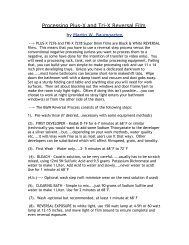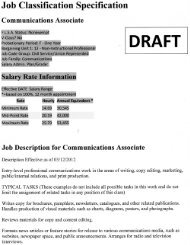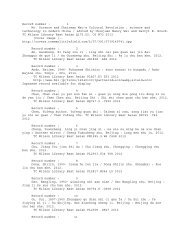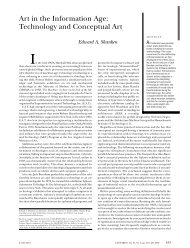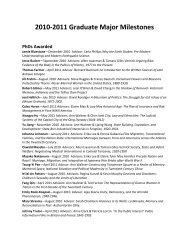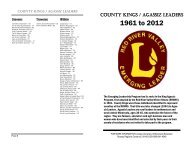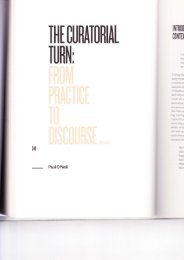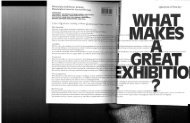Create successful ePaper yourself
Turn your PDF publications into a flip-book with our unique Google optimized e-Paper software.
JoHN ClNrtlw.<br />
SUsAN Howlnn.<br />
Bn'lny Lnwrs
1.<br />
)<br />
Copvzucrn @ 1992,1993 nv JonN CeNrrNe, SusAN Hownno eNo Bnaoy Lpws<br />
3.<br />
ALL RTCTTTS RESERVED, INCLUDING THE RIGFT oF<br />
REPRODUCTION IN WHOLE OR IN PART IN ANY FORM.<br />
h-lusrnlrroNs: Jnuxmen E. MBnnnaeN<br />
Psorocmpus: RrcseRo Krlly<br />
Lavour: Mrcrnel LrveNs<br />
CovBn Ivrace: pnou A Tntp ro rnn MooN sy GEoncBs MBr-rBs<br />
Sru-m pnou A Trup ro rHE MooN aNo MuysRrDGE MorroN sruDy:<br />
THB Museuu op Mooenx Anr/Frlu Sru-ls Ancruvp<br />
rsBN 0-9637433-0-9<br />
4.<br />
5.<br />
6.<br />
7.<br />
Punttsnno nv:<br />
PnrsnuRcH Fu-ivtN,tlxsRs<br />
3712 Fonsps AvsNue<br />
PtrrssuncH,PA 15213<br />
8.
1.<br />
)<br />
3.<br />
4.<br />
J.<br />
6.<br />
7.<br />
8.<br />
PnnrLcn<br />
IurnonucrroN: Tun Movruc flrlcn<br />
Forur'lr. FrlM Sryr,Bs<br />
Cm,rnnl AND LENS<br />
Cluana Mncn,lNrcs. PnoJBcrnl Morrolq. LENsES .<br />
Exposunn . Lrcur MprBnrNc . Focus<br />
Frr,nr Srocx<br />
Nnclrrvn ,lNl Rnvnnslr, Frr,nt . BrACK-lNt-WurrB.qNo Cor-on .<br />
Frr,u SnNsrrrvrty . Cor,on BlrlNco . FIr,u Srocxs<br />
Corrposrrrox<br />
SHors,\l{o lu'lcB SzB . C.qnrnna Ancr,Bs .<br />
CorrposrrroNlr Guront,rNns . ColpostroN OursroB rsn Fruql,rB.<br />
C,twna MovplrnNr. MovEuBNr nq run, Snor<br />
Coxrrxurrv<br />
SplcnlNl TrrrB oN ScnnBN . ScnnBN DrnncrroN . Tur 180-Dpcnnn<br />
RulB . CHlNcrNc ScnnBN DrnBCrroN . MonB Arour CoNrlNurry .<br />
Masrnn Snors,lNt OvpnupprNc AcrroN<br />
Frlnr Enrrrxc<br />
CoNuNurry EorrrNc . Ar,rBnNArrvBs To CoNrtNurry EorrrNG .<br />
EorrrNc Mocullttcs . PnESnNrarroN . CTEANTNc . Sron_q.cp<br />
Pnn-pnonucrroN<br />
WnrrtNc Tnn Frw. PRnpananoxs. FINAT, PtlNNrNc<br />
LrcHrrxc<br />
CnlrucrBnlsrrcs oF Lrcur. LrcuuNc Tools. LrcHrrNc ANGr,es.<br />
Tunpn PorNr LrcnrrNc. Morrv,lrpt Ltcur. CoLoR.<br />
LrcuuNc CoNrnq.sr. Nrcur SHoorrNrc. Suoouxc Trrr,Bs<br />
SouNn<br />
Cn,lrucrnnrsrrcs oF SouNo . TnB SrNn Wlvn, . MrcnopnoNps . prcr-up<br />
PlrtnnNs . RscoRDBns . SrNcr,e-Sysranr SouNo . Dousrn-Sysrplr SouNo<br />
Gr,ossnny<br />
Ixonx<br />
4<br />
6<br />
10<br />
26<br />
34<br />
48<br />
60<br />
70<br />
82<br />
98<br />
110<br />
trg
Slnit book was written because, as teachers, we needed a book that would be<br />
appropriate for beginners in filmmaking. <strong>Shot</strong> By <strong>Shot</strong>: A Practical Guide to<br />
ifimmat
first time it appears in the text. While each of these new terms is defined within<br />
the body of the text the first time it appears, a concise definition of each term can<br />
also be found in the glossary. The chapters are arranged in a logical order. In<br />
some cases a chapter comes later in the book because of background terminology<br />
that is introduced in other chapters. For instance, "Pre-production" is the sixth<br />
chapter in the book. While an argument could be made for discussing pre-production<br />
before anything else, it is impossible to properly outline the concepts of good<br />
pre-production without first having an understanding of the terms, details and<br />
potential pitfalls involved in shooting and editing.<br />
The authors of <strong>Shot</strong> By <strong>Shot</strong>, John Cantine, Susan Howard and Brady Lewis, are<br />
all active independent filmmakers with 25 years of experience in teaching filmmaking<br />
between them. The three authors have also gone through diverse university<br />
filmmaking programs. After taking beginning classes at Pittsburgh Filmmakers<br />
as an undergraduate, John Cantine received his M.F.A. in Film Production<br />
from Ohio University. Susan Howard's B.A. is in Film Production from Pennsylvania<br />
State University, and she has worked on projects as diverse as the low<br />
budget splatter feature Street Trash and, in recent seasons, as the editor of Mr.<br />
Rogers' Neighborhood. Brady Lewis, Pittsburgh Filmmakers' Director of Education,<br />
has a B.F.A. from New York University and his work as an experimental<br />
filmmaker has been recognized <strong>by</strong> many regional and national film production<br />
grants, screenings and festival awards.<br />
We would like to thank several friends who helped us in the final stages of the production<br />
of this text. Gus Samios did extensive proofreading and his suggestions and<br />
comments were invaluable. Marce Schulz, Robert Rutkowski, Dean Mougainis and<br />
Kathryn Borland also gave us technical and stylistic assistance in specific areas.<br />
Charlie Humphrey provided computer expertise as well as help with the artwork and<br />
layout. Electronic Images assisted with the cover artwork. Karen Hignett created the<br />
index. We have discovered that, like making a film, writing a book requires a great<br />
deal of cooperation among the primary collaborators as well as assistance from people<br />
with a variety of skills.<br />
Brady Lewis . Susan Howard . John Cantine<br />
July, 1993<br />
5
E\lUou, the time that inventors began to perfect the photographic process in the<br />
late 19th century, they also began to consider techniques <strong>by</strong> which they could<br />
photographically reproduce motion. Nineteenth century parlor toys such as the<br />
zoetrope and flip books demonstrated that the human eye retains the impression of<br />
an image slightly longer than it is actually exposed to that image' When a sequence<br />
of drawings or photographs of an object in motion are viewed in rapid<br />
succession, the eye blends the individual pictures together. creating the illusion of<br />
motion. This optical illusion is called persistence of vision.<br />
In the 1870's Eadweard Muybridge successfully demonstrated the photographic<br />
reproduction of motion when he set up a fow of still cameras and photographed a<br />
race horse running past them. When viewed in rapid succession these photographs<br />
provided a graphic example of photographed motion. However. setting up a<br />
battery of still cameras to photograph a second or two of action was not a practical<br />
method of photographing motion, and inventors worked to develop a camera<br />
that would rapidly expose a series of sequential images onto a single strip of film'<br />
Ab<br />
tion<br />
pre<br />
Ge<br />
and<br />
Lur<br />
Fc<br />
Inf<br />
35n<br />
the<br />
mill<br />
bee<br />
tive<br />
tar1<br />
tion<br />
caff<br />
A motion sequence photographed <strong>by</strong> Eadweard Muybridge'<br />
The<br />
witl<br />
8m<br />
thrc<br />
filn<br />
filn<br />
wid<br />
slgr
of<br />
A breakthrough in the development of the movie camera occurred with the invention<br />
of flexible celluloid film stock, which replaced the cumbersome glass plates<br />
previously used to capture light and create the photographic image. In 1888<br />
George Eastman marketed the first celluloid film, and in 1890 William Dickson<br />
and Thomas Edison successfully tested a motion picture camera. In 1895 the<br />
Lumiere brothers made the first public motion picture presentation.<br />
)f<br />
Fonrurr<br />
a<br />
hs<br />
n.<br />
In filmmaking the term format refers to the gauge or width of the film stock. The<br />
35mm format, the format used <strong>by</strong> Edison's first motion picture cameras, is still<br />
the standard today in feature and commercial filmmaking. 35mm film is 35<br />
millimeters (about 1 1/2 inches) wide. Over the years, however, other formats have<br />
been developed. In the 1920's the 16mm format appeared as a less expensive altemative<br />
to 35mm. Originally aimed at home users, this format became useful to documentary<br />
filmmakers and newsreel photographers, because its smaller size meant a reduction<br />
in the size and weight of the motion picture camera used to expose it. The smaller<br />
camera improved the filmmaker's mobility and ability to shoot in confined spaces.<br />
The Smm format came into existence tn 1932.Smm film was actually 16mm film<br />
with twice the number of sprocket holes. The 16mm film was run through an<br />
8mm camera which exposed one edge of the film. It was rethreaded and run<br />
through the camera again, exposing the frames on the other side. The processed<br />
fiim was then split down the middle lengthwise, resulting in two reels of Smm<br />
film. In 1965 Eastman Kodak introduced super-8mm film. This format was the same<br />
width as regular Smm, but the sprocket hole size was reduced and spacing was redesigned<br />
to provide a507o larger frame, there<strong>by</strong> greatly improving image quality.
mat<br />
mal<br />
suc<br />
the<br />
c?11<br />
ord<br />
Filmformats.<br />
Frr-vr Srrrr.ns<br />
35mm 16mm 8mm Super-8<br />
Films generally fit within one of three categories: narrative, documentary or<br />
experimental. Many films actually combine elements of two or more of these<br />
groups but can be described broadly <strong>by</strong> one of these terms'<br />
The narrative film is probably the most tecognizable type of film' Almost every<br />
theatrically released motion picture falls within this group' Simply put, a narrative<br />
film tells a story. It is scripted and usually has a linear plot line with a beginning'<br />
middle and end, although the action may not unfold on screen in that order' The<br />
storymaybepresentedinasimplestraightforwardway,asinThelmaandLouise,<br />
or in a very complex way, as rn Last Year at Marienbad. In any case the film is<br />
tellingaStoryfeaturingcharacterswhoseactionsadvancetheplot.<br />
Documentaries are films which depict "real life." A documentary filmmaker uses<br />
the world around him, situations and characters which actually exist' as source<br />
In it<br />
the<br />
defi<br />
sub<br />
req<br />
enc<br />
filn<br />
the<br />
the<br />
sub<br />
ExI<br />
terr<br />
terr<br />
ate<br />
rea<br />
oft<br />
exp<br />
you<br />
ous<br />
rea<br />
ele<br />
tha<br />
filn<br />
and
material. Among the very earliest filmmakers, France's Lumiere brothers began<br />
making documentaries in the 1890's. Their films presented everyday occuffences<br />
such as a train pulling out of a station or workers leaving a factory at the end of<br />
the day. Over the decades filmmakers have documented events of global significance,<br />
such as wars and social upheavals, as well as smaller subjects such as<br />
ordinary individuals.<br />
In its most basic sense the documentary is a film in which the filmmaker allows<br />
the action or events to unfold naturally with minimal interference. However, this<br />
definition breaks down the minute the filmmaker turns his camera from one<br />
subject to another or makes a cut. The very process involved in making a film<br />
requires that the artist manipulate the subject material to some extent. The difference<br />
in documentary style is often a matter of the degree of manipulation the<br />
filmmaker chooses to impose. Because of this, documentary films can range from<br />
the work of Robert Flaherty, who in Nanook of the North actually staged much of<br />
the action, to the "cinema verite" of Frederick Wiseman, who manipulates his<br />
subjects in a subtler way through the editing structure he imposes on his footage.<br />
Experimental filmmaking is the broadest and least easily defined category in<br />
terms of cinematic style. The term "experimental film" seems to be a catch-all<br />
term for any film that isn't a namative or documentary. Often experimental films<br />
are not concerned with presenting a fictional story or documenting external<br />
reality. An experimental film might be more concerned with the graphic elements<br />
of the shots, with the play of light and shadow, color or movement. It might<br />
explore the technical limits of the filmmaking process itself: what happens when<br />
you edit together a series of single-frame shots, or shoot a film that is one continuous<br />
shot? Others might be interested in presenting a vision of internal<br />
reality, images from the filmmaker's unconscious. Frequently, films that combine<br />
elements of narrative with documentary filmmaking (and even animation), films<br />
that blur the boundaries of the usual categories, are classified as experimental<br />
films. In many cases experimental films reject traditional filmmaking techniques<br />
and values in favor of new, often unusual approaches.
AI movie is essentially a series of still images on a strip of film' The exposure<br />
of film in a movie camefa is similar to that in a still camera. The shutter opens<br />
and closes quickly, letting light hit the photosensitive material on the film to<br />
create a latent image. With the shutter closed the film is advanced; then the<br />
shutter opens again, exposing another frame. A movie camera captures the sequence<br />
of movement <strong>by</strong> exposing many separate frames each second.<br />
Ca.lrsna.<br />
MPcgANrcs<br />
upper loop<br />
recamera<br />
gate<br />
apenure<br />
sprocket wheels<br />
lower loop<br />
Diagram of a basic motion picture c&mera'<br />
Movie film comes rolled on the feed reel. As the sprocket wheels turn, the teeth'<br />
or sprockets, engage the perforations (or sprocket holes) in the film, pulling it<br />
through the camera gate. The sprocket wheels turn at a smooth, constant rate' But<br />
if the film went through the camera gate in constant motion the camera would not<br />
IO
-<br />
make separate exposures. Instead, each frame would be a blur. The film must not<br />
be moving when the shutter is open. The camera employs an intermittent movement,<br />
a stop-and-start movement, rather than constant motion to move the film<br />
through the gate. Since the sprocket drive moves constantly and the film in the<br />
gate does not, there must be some slack in the film between the sprocket wheels<br />
and the camera gate or the film will rip. This slack is formed <strong>by</strong> loops of film<br />
above and below the camera gate.<br />
The camera gate consists of two plates. The aperture plate in front of the film<br />
has a rectanguiar opening, or aperture, through which light passes to strike the<br />
film. The pressure plate, behind the film, presses on the film so that it remains<br />
flat against the aperture plate. Without the pressure plate the image would not stay<br />
in focus. In the gate the pull-down claw reaches up, engages a perforation and<br />
pulls the film down one frame. The claw then disengages, reaching up for the next<br />
perforation. While the claw is disengaged, the film is motionless, as light enters<br />
through the camera aperture and exposes a frame of the film. The pull-down claw<br />
completes this cycle many times each second, causing the film's intermittent<br />
movement through the gate.<br />
If light were to hit the film all the time, the intermittent movement would not be<br />
effective. When the film moved it would blur the still frame just exposed. Light<br />
must be blocked from hitting the film while it is moving in order to prevent this.<br />
In a motion picture camera the shutter is a flat disc of metal that spins in front of<br />
the aperture plate. It spins in synchronizationwith the pull-down claw. While the<br />
claw is pulling the film down, the shutter shields the aperture, and no light hits the<br />
moving film. While the pull-down claw is disengaged and the film is still, the<br />
shutter opening is in front of the aperture, and the light exposes the film. The<br />
shutter is often described <strong>by</strong> the size of its opening. A l80-degree shutter, for<br />
instance, is a half-circle of metal. 180 degrees of the circle are metal, and the<br />
other 180 degrees are open, the shutter opening.<br />
After passing through the gate the film forms the lower loop. Then it is engaged<br />
<strong>by</strong> another sprocket wheel, which carries it to the take-up reel, where the film is<br />
1t
j<br />
i<br />
r;n,'l;:::;:'#"::;i:'::i,";;Ti;;;{;;,"i:,"::i::i::f,:.#:::"y,{:;:,<br />
the claw ^<br />
the shutter opening mov-es in front of the,oprrfurc ottowtng ltght to hit the .frame'<br />
")tit"rages ind ttti trtm is again motionless'<br />
PnolPcrED<br />
MorroN<br />
Whentheexposedtilmislatershown,itrunsthroughaprojectorinmuchthe<br />
Samewayitranthroughthecamera.Themaindifferenceisthatinsteadoflight<br />
entering the camera rJ""nor" the film,. a powerful lamp throws through the<br />
film onto a screen. In the projector, as ln ihe camera, a shutter spins and blocks<br />
light while the film is moving so that only still images are seen'<br />
Film moves through a camera or projector at a steadY rate, the frame rate (also<br />
called the camera speed)' which is measuredin frames per second (fps)' "Sound<br />
12
speed," the standard for 16mm and 35mm film, is 24fps. Silent super-8 cameras<br />
run at 18fps, while some super-8 sound cameras run at both 1Sfps and24fps.<br />
Most of the time 18fps is used as the standard speed for super-8 film, but some<br />
filmmakers choose the 24fps standard when shooting super-8 sound film. The<br />
speed of the camera <strong>by</strong> itself does not matter as much as the relationship between<br />
the frame rate of the camera and that of the projector. For motion to look natural<br />
on the screen the projector must run at the same rate as the camera. If the camera<br />
runs faster than the projector, then the result is slow motion. For instance, if the<br />
camera is run at 36fps, then an action that takes one second (e.g. lighting a match)<br />
will take up 36 frames on film. When the film is shown later at 18fps, those 36<br />
frames will take two seconds to run through the projector. Everything will take<br />
twice as long as it did in real life.<br />
Similarly, if the camera runs more slowly than the projector does (undercranHrg),<br />
fast motion will result. For instance, if the camera runs at 9fps, that one-second<br />
feed reel<br />
re<br />
aperture<br />
lamp<br />
pull-down claw<br />
take-up reel<br />
Diagram of a basic film projector.
match lighting will cover 9 frames of film. when run through a projector at 18fps'<br />
these 9 frames will go <strong>by</strong> in half a second; everything moves twice as fast' In time<br />
lapsephotogaphytheframeratemightbeasslowasoneframeeveryl0seconds'<br />
every minute or even every hour. This produces an exffeme compression of time so<br />
that clouds seem to whip through the sky or a flower blooms in a few seconds'<br />
Finally, a word about a type of filmmaking which, strictly speaking, doesn't have<br />
a frame rate at all: animation.In animation, rather than speeding up or slowing<br />
down natural motion, you create motion where none exists. For example, you<br />
shoot one frame of a King Kong model. Then you raise his arm a fraction of an<br />
inch and click off another frame of film. Then raise the arm a bit more' click<br />
another frame, etc. until after hours of work you have 180 frames ending with<br />
King Kong',s arm raised over his head. when projected at 18fps the result is a 10<br />
second sequence of film in which King Kong appears to raise his arm over his<br />
head. By moving inanimate objects slightly between frames the filmmaker can<br />
create the illusion of movement on film. In the same way a series of drawings'<br />
each slightly diff'erent from the last, can be photographed to create animation'<br />
LnNsps<br />
Strictly speaking, the lens is not part of the camera' In fact a lens is not necessary<br />
to expose film, as demonstrated <strong>by</strong> the "pin-hole" camera. A pin-hole camera<br />
consists of a light-tight box with a tiny hole in one side that allows light to enter<br />
the box. Light entering through the pin hole exposes film on the opposite side of<br />
the box. Howevef, it take several seconds for this small amount of light to expose<br />
the film. The basic function of a lens is to gather light rays more efficiently and to<br />
focusthemonthefilmsothatitcanbeexposedmorequickly'<br />
A camera lens consists of several pieces of glass, or elements, connected <strong>by</strong> a<br />
tube called the barrel of the lens. A lens is referred to <strong>by</strong> its focal length' a<br />
measure of the lens, size, usually expressed in millimeters (mm). Any lens introduces<br />
some distortion of perspective into the image. Lenses of different focal<br />
14<br />
ler<br />
du<br />
1e<br />
be<br />
8)<br />
isr<br />
sc<br />
A<br />
in<br />
ho<br />
fre<br />
to<br />
A<br />
ro'<br />
yo<br />
sh<br />
sh<br />
far<br />
un<br />
us<br />
US<br />
lo<br />
in<br />
Ar<br />
m<br />
In<br />
fir<br />
w<br />
1<br />
w(
lengths wili reproduce the same shot in different ways. A "normal,'lens reproduces<br />
an image as closely as possible to the way the human eye sees it, with the<br />
least distortion of perspective. In super-8 a normal lens is one with a focal length<br />
between 9mm and 15mm. A lens with a shorter focal length (under 9mm in super-<br />
8) will gather light rays from a wider angie of view in front of it, and therefore it<br />
is called a wide-angle lens. Wide-angle lenses tend to exaggerate the depth of a<br />
scene. An object will seem farther away from the wall behind it than it actually is.<br />
A woman walking toward the camera wili appear to be moving faster than she is<br />
in reality. Extreme wide-angle lenses also cause horizontal lines to bend. The<br />
horizon line in a landscape, for instance, will curve slightly at either end of the<br />
frame. Because of their short focal lengths wide-angie lenses can also be referred<br />
to as short lenses.<br />
A long or telephoto lens (over 15mm in super-g) accepts light rays from a nar_<br />
rower angle of view in front of it. Small details of the scene will fill the frame. If<br />
you keep the camera the same distance from an actor, a wide-angle lens might<br />
show all of the actor's body and some of the background, a normal iens might<br />
show the actor from the waist up, and a telephoto lens might show just the actor's<br />
face. Since the telephoto lens seems to magnify small details of the scene, any<br />
unsteadiness<br />
the camera will also be magnified, so that a handheld or dolly shot<br />
using a long lens may be unacceptably shaky. If image steadiness is a concern.<br />
use a wide-angle lens. If you are using a telephoto lens, use a tripod. In addition,<br />
long lenses introduce some distortion. In contrast to wide-angle lenses which<br />
increase the perceived depth of a shot, telephoto lenses make the shot seem flatter.<br />
An actor in front of a wall will seem to be right up against it, even though she<br />
might be standing a considerable distance away from it.<br />
In this discussion we've treated lenses as prime lenses. A prime lens has only one<br />
fixed focal length. A long lens is only a long lens, and a wide-angle lens is only a<br />
wide-angle lens. Prime lenses, or fixed focal length lenses, are commonly used in<br />
16mm and 35mm filmmaking. They are rare in super-g though. Most super-g<br />
cameras have a variable focal length lensror zoom lens. A zoom lens can duplicate
the<br />
USU<br />
be<br />
Tht<br />
cha<br />
can<br />
zoa<br />
Ify<br />
sho<br />
zoc<br />
ask<br />
hel<br />
des<br />
mo<br />
Ma<br />
foc<br />
exu<br />
toc<br />
pos<br />
E)<br />
Three shots from the ssme<br />
distunce and camera Position<br />
with different lenses. ToP, wi'deangle<br />
lensl middle, normal lens;<br />
bottom, telephoto lens.<br />
Ina<br />
am<br />
you<br />
you<br />
clo<br />
Ac<br />
con
the effects of a range of lenses, from wide-angle to telephoto. Zoom lenses are<br />
usually referred to <strong>by</strong> the range of focal lengths they cover. A"7 to 40 zoom" can<br />
be used as a 7mm wide-angle lens, a 40mm telephoto lens or anything in between.<br />
The main attraction of a zoom lens is convenience. With prime lenses, in order to<br />
change your composition from a long shot to a close-up, you must either move the<br />
camera or remove the lens and replace it with another. Using azoomlens, you can<br />
zoom in to a close-up or zoom out to a long shot <strong>by</strong> just turning a dial.<br />
If you change focal lengths while the camera is running the result is a "zoom"<br />
shot. In general, excessive zooming can be very annoying. Before you use the<br />
zoom effect in a shot, as with any other camera movement, you should stop and<br />
ask yourself why you want to do it. Is there a legitimate reason? Will the zoom<br />
help your film or are you just bored? Zooms,like dollies, pans or tilts, should be<br />
designed to add or reveal important information within a shot. Zoomrng that is not<br />
motivated can be distracting and can look sloppy.<br />
Many super-8 cameras also have a macro lens setting. Since most lenses cannot<br />
focus on anything closer than four feet away, a special lens is needed to shoot<br />
extreme close-up shots. A macro lens can focus on objects from a few feet away<br />
to objects within millimeters of the lens. If you want to fill the frame with a<br />
postage stamp or show a cricket on a stalk of grass, use the macro lens.<br />
Exposunp<br />
In addition to gathering and focusing rays of light, lenses are used to control the<br />
amount of light reaching the film. when you enter a dark room on a sunny day,<br />
you can't see anything at first. Slowly your eyes adjust to the low light level, and<br />
you can see details. The eye adapts to varying amounts of light <strong>by</strong> opening or<br />
closing its iris to let the right amount of light reach the retina.<br />
A camera lens also has an iris, a metal diaphragm that can be opened or closed to<br />
control the amount of light reaching the film. If too much light hits the film, it will
e overexposed. If too little light hits the film, it will be underexposed' The right<br />
amount of light is determined <strong>by</strong> the speed (sensitivity to light) of the film. A<br />
faster (high ASA number) film needs less light than a slower (lower ASA number)<br />
film. Film speed and ASA numbers are discussed in detail in Chapter 2'<br />
Whatever the speed of the film, it always needs a specific combination of amount<br />
of light and exposure time to be correctly exposed. The amount of light hitting the<br />
film can be controlled in two ways: <strong>by</strong> actually changing the amount of light in<br />
the scene or <strong>by</strong> opening or closing the lens iris. The film's exposure time. or<br />
shutter speed, can only be controlled <strong>by</strong> changing the camera's shutter angle or<br />
<strong>by</strong> changing its running speed (fps). If you are shooting outside on a sunny day,<br />
it's hard to change the amount of light in the scene. often you have to use the<br />
available light in a scene. Similarly, most motion picture cameras don't allow you<br />
to change their shutter angle, and changing a camera's running speed to control<br />
exposufe time is rarely an option, since a change in the frame rate also results in a<br />
change in the speed of motion on the screen.<br />
As discussed earlier, the shutter of a motion picture camefa rotates in front of the<br />
aperture plate, alternately letting light hit the film and then blocking light out' The<br />
shutter speed is the actual length of time that the shutter lets light hit each frame<br />
of film. To let more light hit the film, the shutter opening must be in front of the<br />
film longer. To achieve this the shutter must spin more slowly. Since the shutter<br />
of a motion picture camera is synchronized to the camera's intermittent drive, the<br />
only way to slow the shutter down is to slow down the camera's frame rate. For<br />
instance, at gfps the shutter willlet light hit the film twice as long as it would at<br />
18fps. However, shooting at gfps will result in fast motion' So, while manipulation<br />
of the shutter speed might be a viable means of controlling exposure for a<br />
still photographer who shoots one picture at a time, for the motion picture photographer<br />
changing the shutter speed is seldom an effective way to control the exposure<br />
of the film.<br />
In most cases the best way to control the amount of light that hits the film is <strong>by</strong><br />
opening or closing the iris in the lens. Just as the shutter speed determines how long<br />
18<br />
lit<br />
lie<br />
tu<br />
ca<br />
TI<br />
inr<br />
fil<br />
Ar<br />
SN<br />
ge<br />
ftt<br />
str<br />
If<br />
EX<br />
thr<br />
NU<br />
le<br />
M<br />
iri<br />
m<br />
AU<br />
SU
light will hit each frame, the size of the iris opening will determine hotu much<br />
light hits the frame. (Note: the iris opening is often referred to as the lens aperture.<br />
Do not confuse this adjustable aperture in the lens with the aperture in the<br />
camera gate, which is simply a frame-sized window cut into the aperture plate.)<br />
The size of the lens aperture is expressed as an f-stop. An f-stop is a number that<br />
indicates the size of the opening of the lens aperture (oriris). Every serious<br />
filmmaker should memorize the f-stop series:<br />
| 1.4 2 2.8 4 5.6 8 11 t6 22 32 45<br />
"stopping down<br />
As the f-stop numbers get higher, the size of the lens aperture is actually getting<br />
smaller, letting less light in. As the f-stop numbers get lower the aperture opening<br />
gets larger, letting more light in. Every time you open up one stop (from f/4 to<br />
f/2.8, for instance) you double the amount of light reaching the film. when you<br />
stop down one stop (from fl4 to f/5.6, for instance) you let half as much light in.<br />
If you change <strong>by</strong> more than one stop, every stop doubles or halves the light. For<br />
example, if you open up 3 stops (from f/4 to f|l.4, for instance), then you double<br />
the light 3 times to let in: 2x2x 2 = 8 times as much light. The list of f-stop<br />
numbers above is not exhaustive, but a filmmaker will rarelv. if ever. deal with<br />
lens openings larger than f/1 or smaller thanf/45.<br />
Lrcrrr<br />
MnrpnrNc<br />
Most super-8 cameras have a built-in light meter which can control the automatic<br />
iris. In effect the camera functions as two distinct instruments; a reflected light<br />
meter to measure light and a camera to take pictures when the camera is in its<br />
automatic mode. The camera's light meter reads the amount of light reflected <strong>by</strong> the<br />
subject, and then it automatically sets the camera's lens aperture to the coffect f-stop.<br />
19
It is important to understand how reflected light metels work. The reflected light<br />
meter that is built into a super-8 camera, and every reflected light meter for that<br />
matter, is built and calibrated upon a medium gray standard' These meters are<br />
designed so that they give you a light reading (an f-stop number), which is the<br />
correct exposure to use when you want the subject seen <strong>by</strong> the meter to be reproduced<br />
on the film in tones that are equivalent to medium gray (also known as<br />
neutral gray or l87o Sral). Since most shots represent a variety of brightness,<br />
including light, dark and medium tones, the reflected light meter gives an average<br />
of what it sees. In many cases these light, dark and medium tones do, in fact,<br />
average our to something close to the medium gray standard, and exposure will be<br />
correct. The standard was developed based on the assumption that most shots<br />
have a range ofbrightness that averages out to a shade of gray that reflects l87o of<br />
the light striking it.<br />
In a so-called average Scene, a Scene which contains afange of brightness but is<br />
not dominated <strong>by</strong> very light or very dark objects, the light reflected <strong>by</strong> all the<br />
objects within the scene will average out to something close to anI87o reflectance'<br />
In this case the light reading given <strong>by</strong> the super-8 camera's reflected light meter<br />
will be correct. If you were to use the reflected light meter to take a reading from<br />
an object that reflects exactly l87o of the light striking it (for instance, an lSvo<br />
gray card), the reading you would get would be the perfect f-stop setting to use if<br />
you want the object to look medium gray on the film. This, again, is because the<br />
standard is based upon 187o gray. If you were to take your light reading from a<br />
black object (a black cat, for example) or from a scene dominated <strong>by</strong> dark tones,<br />
the f-stop reading you would get would result in overexposure' Instead of looking<br />
black on the film, the black cat would appear to be medium gray. Everything else<br />
would be brighter too. Similarly, a reflected light meter reading of a white scene<br />
(a snow- covered hill with a bright sky behind it) would give an f-stop reading<br />
that would result in underexposure. The white hillside and sky would look medium<br />
gray rather than white on the film'<br />
Clearly, when taken atfacevalue, reflected light meter readings are good for<br />
some situations and not for others. A reflected light meter always gives a reading<br />
20<br />
tl<br />
S<br />
o<br />
tl<br />
a<br />
P<br />
ti<br />
ir<br />
b<br />
1<br />
r(<br />
ta<br />
\<br />
r(<br />
a<br />
g<br />
I<br />
D<br />
n<br />
!<br />
r(<br />
Sl<br />
^l S]<br />
S<br />
n<br />
o<br />
+ t'<br />
n<br />
ti
that will reproduce what the meter sees as medium gray on the film. That is to<br />
say, if the reading is taken from an 18% gray card, the f-stop indicated will be the<br />
correct setting to make that card look medium gray on film. Therefore, all the<br />
other brightness values in the scene should be rendered correctly as well. Objects<br />
that are brighter (or more reflective) than l87a gray will look brighter on the film,<br />
and darker (less reflective) objects will appear darker on the film.<br />
Problems arise when the subject being read <strong>by</strong> the meter is considerably darker or<br />
lighter than medium gray. Scenes dominated <strong>by</strong> extremes of brightness can result<br />
in light readings that are severely overexposed or underexposed. This problem can<br />
be overcome if you simply use the standard (187o gray) to which the reflected<br />
light meter is calibrated. In the case of the black cat, you would take a light<br />
reading from an 18% gray card (in the same light that is illuminating the cat)<br />
rather than taking a reading of the cat itself. In the case of the snowy hillside, you<br />
would read an l87a gray card, not the white hillside. As long as the gray card is<br />
read under the same light that illuminates the subject, these readings will give you<br />
an f-stop that would render a medium gray subject (the card) looking medium<br />
gray on the film, instead of readings that would make black or white look medium<br />
gray on the film. If you get a reading that would properly reproduce medium gray as<br />
medium gray on fllm, it should also reproduce brighter and darker tones properly.<br />
When a super-8 camera is set to the automatic setting, the light meter built into the<br />
camera will take readings and simultaneously set the lens iris (the f-stop) to the<br />
reading obtained. The automatic iris is always adjusting to the light. If the actor in a<br />
scene is walking down a dark hallway, the iris will open up to make it look brighter. If<br />
she walks past a bright window, the light meter will read the extra light and suddenly<br />
stop the lens down, and the actor will be underexposed. Overall, relying on the automatic<br />
iris can result in poorly exposed fllms. On most cameras the filmmaker can<br />
override the automatic iris, and <strong>by</strong> using a medium gray card, set the iris to the conect<br />
f-stop. By taking an automatic light meter reading of an l87o gray card and then<br />
manually adjusting the lens iris to the f-stop indicated, a filmmaker using a reflected<br />
light meter can avoid most of the pitfalls of this kind of metering system.<br />
21
Because all super-8 cameras incorporate a reflected light metering system, this<br />
discussion has concentrated on reflected light meters' Incident light meters are<br />
preferred <strong>by</strong> most filmmakers. These meters measure the amount of lightfalling<br />
on the subject rather than the light reflected <strong>by</strong> the subject' Using an incident<br />
meter a black cat, awhite rabbit and an 187o gray card under the same light wil^<br />
give the same reading. In effect, an incident light meter is like a reflected light<br />
meter with a built-in gray card. A reflected meter used in conjunction with an<br />
I87o gray card will give the same readings an incident light meter gives'<br />
The primary function of a lens is to gather light rays and focus them onto the film'<br />
By adjusting the glass elements in a lens, you can focus on objects at different<br />
distances from the camera; the numbers on the focusing ring of the lens tell you<br />
what distance you are focused on. If you set the focusing ring at ten feet, for<br />
instance, all objects on a plane ten feet away will appear to be in focus' The plane<br />
of critical focus is ten feet away. (Note: when measuring focus, one doesn't<br />
measure from the end of the lens, but from the frlm plane or focal plane, which is<br />
marked on the camera <strong>by</strong> u 0 symbol.) Objects in front of or behind the plane of<br />
critical focus will appear to be out of focus; the farther they are from the plane of<br />
critical focus, the more out of focus they appear. Objects that are close to the<br />
plane of critical focus ale so slightly out of focus that they seem to be in focus'<br />
Rather than just a flat plane being in focus, there is actually a field in front of and<br />
behind the plane of critical focus which appea.rs to be in focus. This area, defined<br />
<strong>by</strong> the near and far limits of acceptably sharp focus in a given situation, is known<br />
as the depth of field.<br />
Depth of field is not a constant. It can be a few inches, or it might be hundreds of<br />
feet. Depth of field depends on three variables:<br />
1. Focalength: Shorter (wide-angle) lenses provide Sreater depth of<br />
field than long (telephoto) lenses.<br />
2. tris opening: Stopping down the iris increases depth of<br />
field; openini ,p decreases depth of field. Therefore, you will<br />
The<br />
rule<br />
you<br />
of fi<br />
so a<br />
near<br />
t-<br />
k<br />
Two<br />
lens<br />
The<br />
foca<br />
pers<br />
foct<br />
out<br />
pro(<br />
bec<br />
cha<br />
betr
usually have less depth of field in Iow lighting, when the lens iris<br />
must be opened up.<br />
3. Focusing distance: The farther the subject is from the camera, the<br />
greater the depth of field; the closer the camera is focused, the less<br />
the depth of field.<br />
The final thing to keep in mind about depth of field is the "one-third two-thirds<br />
rule." That is, if there are two subjects at different distances from the camera that<br />
you want to have equally in focus, do not focus halfway between them. The depth<br />
of field extends farther behind the plane of critical focus than it does in front of it,<br />
so as a general rule you should focus on a point one-third of the way beyond the<br />
nearer of the two subiects.<br />
Two shots with the same image size. Depth of jield is much greater when using a wide-angle<br />
lens (l) thqn when using a telephoto lens (r).<br />
The correct way to focus a zoom lens is to focus with the lens set at its longest<br />
focal length. Even if you are shooting a long shot of a person, zoom in on the<br />
person <strong>by</strong> turning the zoom ring on the lens to its telephoto position. Adjust the<br />
focusing ring until this magnified image is sharp in the viewfinder. Then zoom<br />
out and compose the long shot. Each shot should be focused <strong>by</strong> following this<br />
procedure. Zoom lenses should always be focused in the telephoto position,<br />
because you can see greater detail when the image is magnified. Focus does not<br />
change when the focal length is changed. Focus is dependent upon the distance<br />
between the camera and the subiect.<br />
23
f<br />
$<br />
I<br />
5<br />
u3 + 2/3<br />
f<br />
sup<br />
ofs<br />
The one-third two-thirds rule.<br />
feet<br />
flr.4<br />
near<br />
fqr<br />
f/2 near<br />
far<br />
f/2-a<br />
near<br />
far<br />
fl4 near<br />
far<br />
fl5-6<br />
near<br />
far<br />
fla<br />
near<br />
far<br />
fltr<br />
near<br />
far<br />
oo 7',10" 5'7" 4',7 3', 1'8" 1',3 " 1<br />
fl16<br />
near<br />
far<br />
35 6'7" 4'.71 3',9" 2'70" 2',2" r'-7" 1',3 " 1<br />
20 5'1(]" 1'6" 3',6" 2'8" 2'1" 7'.'7" I',3" 1<br />
10 4'4" 3'1()" 3'l 2'5" 1'11 1',6" 1'3 " I<br />
7 3'lI"<br />
42'4"<br />
3',4" 2'lo" 1',10" 1',8" l'2" 11"<br />
5<br />
ll'4"<br />
2'7 l"<br />
26'.7"<br />
2'6" 2'l 1'9" I'5" L'2" ll<br />
4 2',1o"<br />
a'1I"<br />
2',7"<br />
10'4"<br />
31'9"<br />
l'1 I 1'8" l':t" 7'.2" 11<br />
I<br />
Super-8 d.epth qf .fielit table for a lens with afocal length of 8mm showing near andfar limits of<br />
ii[eptabty'shoip"Torut at various f-stop and focusing distance combinations.<br />
su<br />
of (<br />
24
feet<br />
fl7,.4<br />
near<br />
fl2<br />
near<br />
f/2.4<br />
near<br />
f/4<br />
near<br />
f/5.6<br />
near<br />
f/a<br />
near<br />
fltl<br />
near<br />
flt6<br />
near<br />
€ t7'1 l2' 8'6" 6',2" 4'5" 1'8"<br />
35 I l'8" 9'2" a'4" 1', l'8"<br />
20 9'5" 7'.9" 6'3" :+' 1O" 3'9" 2',1o" 2',2" 1'7 "<br />
10 6'6"<br />
22',7"<br />
7 5'2"<br />
11'1"<br />
5',8"<br />
46',7"<br />
4'8"<br />
l4'10"<br />
,+'10" 4'. 2',7" 2',1 l'7 "<br />
4'1" 3'6" 2',1 t" l'l I l'6"<br />
5<br />
6'6"<br />
3'9"<br />
7',9"<br />
3'4"<br />
lo'<br />
3'<br />
18'<br />
2',7" z',2" 1'9" t'5"<br />
4 3'.1"<br />
4',1|<br />
3',2"<br />
5'6"<br />
z'.7 |<br />
6',6"<br />
2','7"<br />
6'l I t7"t 7<br />
2'. 1',4" 7'1"<br />
Super-8 depth of jield table for q lens with afocal length of 12mm showing near andfar limits<br />
ofacceptably sharpfocus atvariousf-stop andfocusing distance combinations.<br />
feet<br />
flL.4<br />
near<br />
f/2<br />
near<br />
f/2.4<br />
near<br />
t/4<br />
near<br />
t/s.6<br />
near<br />
f/a<br />
near<br />
f/tl<br />
near<br />
fqr<br />
f/r6<br />
near<br />
€ ^41<br />
294', 27O'. 147' 1 05', 52'10 36',1<br />
35 32',4"<br />
38'2"<br />
31'3"<br />
39'9"<br />
30'<br />
42'<br />
2a'3"<br />
,18'l O<br />
26',2"<br />
52',4" 66'.2" 9a'7"<br />
t7'4"<br />
211'.<br />
20 l9'l<br />
2t'<br />
l8'9"<br />
2l'a "<br />
18'3 "<br />
22',1"<br />
l7'7"<br />
23'2"<br />
t6'9"<br />
24'4"<br />
l5'8 "<br />
27',5"<br />
l z1'5 "<br />
31'9"<br />
12'10<br />
43',<br />
10 9'.9"<br />
ro'3"<br />
9',8"<br />
70'4"<br />
9'.6"<br />
ro'6"<br />
9'.4"<br />
10'9"<br />
9'1 "<br />
I 1'1<br />
8'9"<br />
11',1"<br />
8'4"<br />
12',1"<br />
7',9"<br />
13'9 "<br />
7 6'l 1<br />
'7',2"<br />
6'lo"<br />
7'2"<br />
6',9"<br />
7',3"<br />
6'8"<br />
'7',4"<br />
6'.6"<br />
-7'6"<br />
7'9"<br />
6',2"<br />
8'1"<br />
5'9"<br />
8'9"<br />
5 4't7<br />
5'1 "<br />
4',11<br />
5'1 "<br />
4'.to"<br />
5',2"<br />
4'1 0"<br />
5'.2"<br />
4',9"<br />
5'3 "<br />
4'4"<br />
5'5"<br />
4',6"<br />
5'7"<br />
4'1"<br />
5'l l"<br />
4 3',1 I<br />
4',l"<br />
3'l I"<br />
4',1"<br />
3'1 1<br />
4'1 "<br />
3'10"<br />
4',2"<br />
3'1 0" 3'9"<br />
4'.3"<br />
3'8"<br />
4'5"<br />
3'6"<br />
4'7"<br />
Super-8 depth of jielil table for q lens with a focal length of 60mm showing near and far limits<br />
of acceptably sharp focus at various f-stop and focusing distance combinqtions.<br />
25
At its most basic level a motion picture is a strip of film, a flexible base<br />
(made of cellulose triacetate), thinly coated on one side with a chemical emulsion.<br />
This emulsion consists of light sensitive grains of silver compounds suspended<br />
in a gelatin. When the emulsion is exposed to light, a chemical reaction<br />
occurs. The grains that are exposed to light change their chemical structure. Those<br />
which are not exposed remain unchanged. At this point no image is visible on the<br />
film. It contains a latent image. In fact, if you were to look at the film immediately<br />
after exposure, it would not only look unchanged, but you would ruin your film,<br />
because the emulsion is still light sensitive. To render the film insensitive to light and<br />
to bring out the latent image, the film must be processed in a chemical developer.<br />
When a film stock is manufactured, the cellulose triacetate (celluloid) base material<br />
is coated with an emulsion of light sensitive silver compounds called silver<br />
halides. During exposure and processing some of these silver halides are converted<br />
into grains of metallic silver. Where more exposure takes place, more<br />
metallic silver is formed.<br />
an<br />
im<br />
mt<br />
ori<br />
thz<br />
or(<br />
pri<br />
to<br />
Re<br />
thr<br />
VA<br />
ce<br />
lig<br />
a\<br />
po<br />
Nnc,lrrvE AND RPvn'nsAL FrLM<br />
Film stocks can be described as either negative or reversal film. When shooting<br />
negative film, the emulsion that has been exposed to light is converted to metallic<br />
silver <strong>by</strong> the developer. The unexposed emulsion is washed away. Where a lot of<br />
light hit the film, a lot of metallic silver is left. Where no light hit the film, all of<br />
the emulsion is washed off; the negative film is clear in these areas. If run through<br />
a projector, light would shine through these clear areas, making a bright area on<br />
the screen. Where higher concentrations of metallic silver are left, less light would<br />
shine through the film. If enough light has exposed the film, it will be practically<br />
opaque in that area. So with negative film, what was bright leaves a dark image,
and dark objects create bright images. Brightness values are reversed; a negative<br />
image is obtained. To restore tonalities to their proper values, a positive print<br />
must be made. A filmmaker using negative film does not project the camera<br />
original film, the negative film that ran through the camera. It is the positive print<br />
that is handled and projected. This is similar to shooting still photographs and<br />
ordering prints. Strips of negative are returned along with your prints, but it is the<br />
prints that you show to your friends. The negatives are only used when you want<br />
to make additional prints.<br />
Reversal film is similar to slide film. When you mount a slide, you are mounting<br />
the original film that was exposed in the camera, yet the brightness and color<br />
values are not reversed. This is due to the fact that when reversal film is processed,<br />
the emulsion that has rcacted to light is bleached away. So where a lot of<br />
light has hit the film, a lot of emulsion becomes metallic silver and is bleached<br />
away, and the film is clear. Where no light has hit the film, a thick layer of unexposed<br />
emulsion is left.<br />
Tnn nnvnnsAl FrLM pRocESS:<br />
1. Silver halide grains are exposed to light.<br />
2. Exposed grains are converted to silver.<br />
3. Silver grains are bleached away.<br />
4. Remaining emulsion is re-exposed to light<br />
in the lab and a positive image remains.<br />
27
In reversal processing that remaining emulsion is re-exposed to light in the laboratory<br />
and then developed again, so that it becomes metallic silver. What was bright<br />
in front of the camera is bright on the screen. What was dark appears dark on the<br />
screen. The brightness values remain the same as in real life. As a side effect, the<br />
emulsion that is left after developing is harder and more resistanto scratches than<br />
negative emulsion. It can therefore be run through a projector without being easily<br />
scratched. A11 super-S films available today are reversal films. Usually filmmakers<br />
who are working in the super-8 format handle and edit their camera original<br />
film rather than having a print made. It is possible to make a reversal film print from<br />
a reversal camera original, but it is very difficult to get good quality in a super-8 print.<br />
Br.a,cr-AND-\<br />
/rrrrE AND Cor-on<br />
Another way to describe a film stock is <strong>by</strong> its color characteristics. Black-and-white<br />
(b&w) films do not react differently to different colors and do not reproduce colors on<br />
the film. Only brightness values are reproduced. If a red object reflects light as<br />
brightly as a green object, they will both appear as the same shade of gray on blackand-white<br />
film. The color film process involves the use of colored dyes. Color films<br />
react to and reproduce the colors of objects in the shot. While the image on a strip of<br />
black-and-white film consists of varying densities of metallic silver, a color film<br />
image consists of various intensities of three different colored dyes.<br />
Frr-rvr SpNsrrrvrrY<br />
It is also possible to describe film stocks in terms of their sensitivity to light, or<br />
their speed. In a fast film the grains are larger and more sensitive to light. Less<br />
light is needed to cause them to react. Slow films have small, fine grains, and they<br />
require more light to achieve the same reaction. A slow film needs more light than<br />
a fast film. The speed of a film is expressed <strong>by</strong> an ASA (American Standards<br />
Association) number. ASA numbers are a way to measure the sensitivity to light one<br />
film stock has in relation to another. A film rated at ASA 100 is twice as sensitive<br />
as a film rated at ASA 50. It needs half as much light to gain the same exposure.<br />
28<br />
Afr<br />
con<br />
sun<br />
AS,<br />
ore<br />
inte<br />
(De<br />
Afi<br />
isp<br />
ima<br />
use<br />
slor<br />
bel<br />
me<br />
wan<br />
wel<br />
An)<br />
mu(<br />
will<br />
able<br />
ove<br />
colc<br />
pos<br />
mar<br />
sha<br />
The<br />
losi<br />
thar<br />
rev(<br />
eve
A film stock with a very high ASA number is best to use under low lighting<br />
conditions like you might find indoors. If there is plenty of light (outside on a<br />
sunny day, for instance) you might want to use a slower film, one with a lower<br />
ASA number. Note: ASA numbers are the same as ISO (International Standards<br />
Organization) numbers and EI (Exposure Index) numbers, and they can be used<br />
interchangeably with these other standards. They are not the same as DIN<br />
(Deutsche Industrie Norm) numbers, the European standard.<br />
A film is more sensitive to light if its light sensitive grains are larger. When a film<br />
is projected onto a large screen, these grains are easy to see, and they make the<br />
image lose some of its sharpness. That is one reason a filmmaker might want to<br />
use as slow a film as the light level will permit. Conventional thinking is that<br />
slow, fine grained film stocks produce sharper, more realistic and therefore more<br />
believable pictures. They don't distract the audience <strong>by</strong> drawing attention to the<br />
medium or the photographic process. Of course, there might be times when you<br />
want to do just that, so the choice of a film stock can be an aesthetic option as<br />
well as a practical one.<br />
Any film stock needs a certain amount of light to get the correct exposure. If too<br />
much light hits the film, it will be overexposed; if too little light hits it, the film<br />
will be underexposed. If the film is overexposed too much, the film will not be<br />
able to handle the light and will begin to burn out and lose detail. In a greatly<br />
overexposed shot of the sky, for instance, the sky will be clear white. The blue<br />
color and the clouds will be washed out <strong>by</strong> too much light. If the film rs underexposed<br />
too much, then again details get lost. In a severely underexposed shot of a<br />
man standing in the shadows, the film will show only a black mass where the<br />
shadow is. The man will be lost in the underexposed area.<br />
The amount of overexposure and underexposure a film stock can handle without<br />
losing detail is called the latitude of the film. Negative film has greater latitude<br />
than reversal film. It can handle a greater range of brightness values. Super-8<br />
reversal film has a very limited latitude. If you underexpose or overexpose it <strong>by</strong><br />
even one stop, you will begin to lose detail in the darkest or brightest areas.<br />
29
Cor-on Ba.r-nNcn'<br />
Using color film introduces an important point to the filmmaker: all light is not<br />
the same color. If you are reading this book outside in the sunlight, you see the<br />
sunlight reflecting off the page as white light. If you are inside reading <strong>by</strong><br />
lamplight, you also see the light reflecting off the page as white light. This is<br />
because the eye and the brain, within certain boundaries, adjust to variations in<br />
the color of the light and see the dominant light as white. In fact, daylight is much<br />
bluer than lamp light. You can see this easily when you are outside in the late<br />
afternoon and the lights have been turned on inside. The tungsten light seen<br />
through the windows of a house looks ofange because your eyes are adjusted to<br />
the blue daylight. When you enter the house your eyes quickly adjust to the<br />
tungsten light, and it appears white.<br />
Although your eyes can adjust to variations in the color of light, film cannot. The<br />
light sensitive emulsion must be color balanced in the manufacturing to see one,<br />
and only one, kind of light as white light. Daylight-balanced film reads daylight<br />
as white light. When using daylighrbalanced film, tungsten incandescent light<br />
will look orange. Tungsten-balanced film sees light from tungsten sources (such<br />
as movie lights, household light bulbs ,but not fluorescent lights) as white light,<br />
and daylight will look too blue. Most super-8 color films are tungsten-balanced.<br />
when shooting tungsten-balanced film in daylight an orange filter must be placed<br />
in front of the film. As the blue daylight passes through the filter, it is converted<br />
to the orange color of tungsten light.<br />
15'<br />
yol<br />
col<br />
pei<br />
wl<br />
ligJ<br />
ker<br />
sig<br />
ou<br />
Th<br />
fih<br />
lig<br />
sh<<br />
sli<br />
da<br />
ho<br />
ou<br />
dis<br />
oc<br />
ou<br />
If this sounds a little confusing, it is very easy to deal with in super-S. Most<br />
cameras have a filter switch with two settings: ? 1a hght bulb) 2n6,;Ql:(the sun).<br />
When shooting color film under tungsten lights, set the filter switch to the ?<br />
position, and the filter is out.Itdoes not affect the light. When shooting color film<br />
with daylight as your light source set the switch to the,Oiposition, and the filter
is in, making the daylight orange like tungsten light. In other words, wherever<br />
your light is coming from, the sun or a light bulb, set the filter switch to the<br />
corresponding position. (Note: On tungsten-balanced film fluorescent light appears<br />
greenish, and putting the filter in is usually better.)<br />
When the filter is in it absorbs some of the light passing through it so that less<br />
light reaches the film. For this reason if you are shooting black-and-white film,<br />
keep the filter out (the? position). Since black-and-white film does not react<br />
significantly to color variations anyway, you do not need the filter and leaving it<br />
out allows the maximum amount of lisht to reach the film.<br />
The one super-8 color film that is not tungsten-balanced is Ektachrome Type G<br />
film. This film is balanced half-way between tungsten and daylight. Tungsten<br />
light will seem slightly orange and daylight slightly blue when Type G film is<br />
shot without filtration. when shot with the filter in place daylight will seem<br />
slightly orange, since the orange filter in a super-S camera is designed to match<br />
daylight with film that is tungsten-balanced. Kodak devised Type G film for the<br />
home movie consumer market. Its advantage is that the user can leave the filter<br />
out all the time and the error in color reproduction won't usually be very great. Its<br />
disadvantage is that color reproduction is never coffect. The only exception<br />
occurs when shooting under fluorescent lights where type G film, with the filter<br />
out, may give better color reproduction than Type A film.<br />
For a more detailed discussion of color, please see Chapter 7: Lighting.<br />
31
Frr.nn Srocrs<br />
These are the individual super-8 film stocks that are available from Eastman Kodak:<br />
-<br />
Black'and-white:<br />
Plus-X<br />
Tri-X<br />
ASA 50 (in daylightVo filter)<br />
ASA 200 (in daYlightVo filter)<br />
Color:<br />
Kodachrome40<br />
Ektachrome 160A<br />
Ektachrome 1 50 C<br />
ASA 40 tungsten;<br />
ASA 25 w/filter<br />
ASA 160 tungsten;<br />
ASA 100 w/filter<br />
ASA 160 Vo filter;<br />
ASA 100 wfilter<br />
(Note: Black-and-white films have a nominally lower ASA rating under tungsten<br />
lightthantheyhaveunderdaylight.Thisisbecauseblack-and-whitefilmsare<br />
slightlymoresensitivetobluelightthantootherpartsofthespectrum,and<br />
daylightcontainsanabundanceofbluelight.Nofiltrationisnecessarywhen<br />
shooting black-and-white film, regardl.r, of th" type of light illuminating the subject')<br />
All of these films are packaged in light-tight plastic cartridges containing 50 feet<br />
of film, which is ttrree minutes and20 seconds running time at tSfps (or two<br />
minutes and 30 seconds at24fps).There atel2individual frames in one foot of super-<br />
8film,soatlsfpsittakesfoursecondsforonefoottomovethroughthecamera.<br />
32



